One of the lesser-known but fascinating parts of Japanese culture is that of the Ama pearl divers. Ama (海女 in Japanese), literally means ‘woman of the sea’ and is recorded as early as 750 in the oldest Japanese anthology of poetry, the Man’yoshu. These women specialised in freediving some 30 feet down into cold water wearing nothing more than a loincloth. Utilising special techniques to hold their breath for up to 2 minutes at a time, they would work for up to 4 hours a day in order to gather abalone, seaweed and other shellfish.
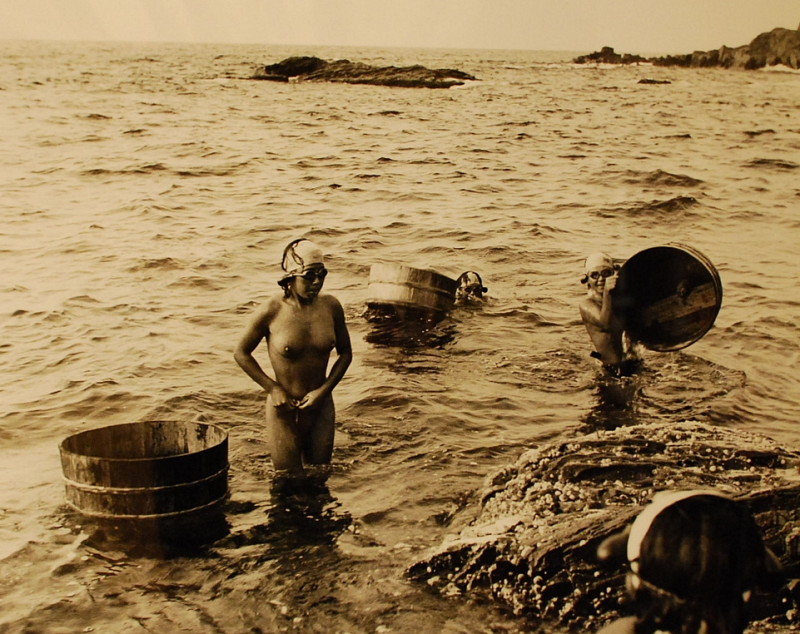
The most profitable pursuit however was diving for pearls. Traditionally for Ama, finding a pearl inside an oyster was akin to receiving a large bonus while they went about their ancestral practice of collecting shellfish. That changed when Kokichi Mikimoto, founder of Mikimoto Pearl, began his enterprise.
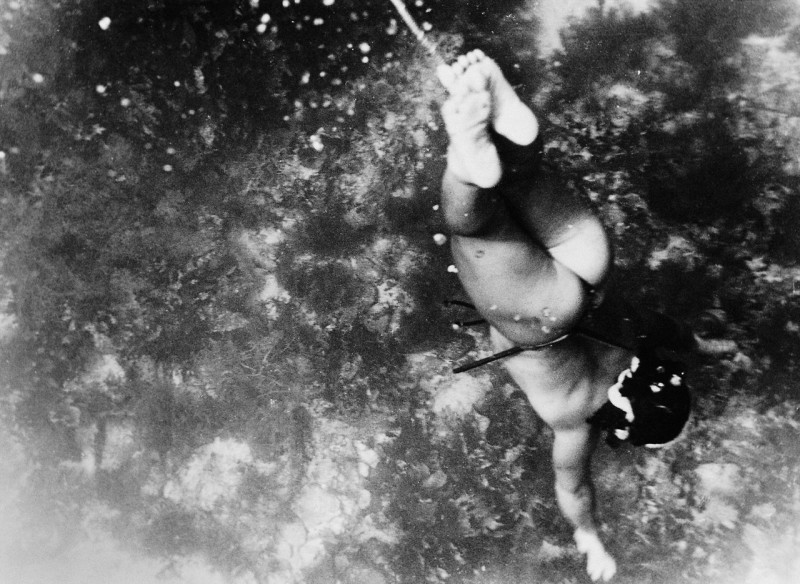
Mikimoto used Ama divers to look after his cultivated pearls on Mikimoto Pearl Island, near Toba city. This business was the main reason for the strong association between Ama and pearl diving among foreign observers that continues to this day. Another little-known fact is that the ‘traditional’ white attire we often see Ama divers wearing was also created by Mikimoto. He observed how surprised the foreign tourists visiting his pearl island were when seeing the Ama diving naked wearing only their traditional loincloth. (Source)
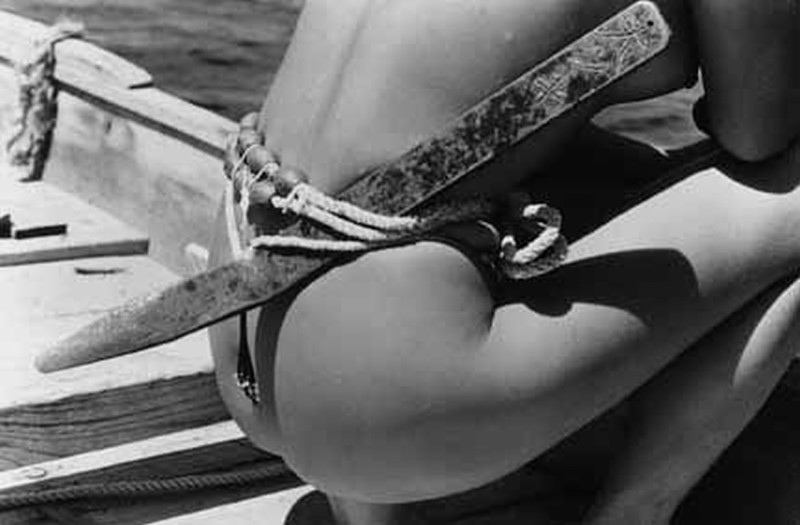
(Fosco Maraini)
The role of the Mikimoto ama was to collect the oysters from the seabed so that the pearl-producing nucleus may be inserted. Once this critical process was completed, the ama then carefully returned the oysters to the seabed – in a place where they were protected from external dangers (such as typhoons and red tide).
In order to successfully complete this process, each diver would have to hold her breath for up to two minutes at a time in often freezing cold waters. Upon surfacing, the ama opened their mouths slightly and exhaled slowly, making a whistling sound known as ‘Isobue’.
While traditional ama divers wore only a fundoshi (loincloth) to make it easier to move in the water and a tenugui (bandanna) around their head to cover their hair, Mikimoto ama wore a full white diving costume and used a wooden barrel as a buoy. They were connected to this buoy by a rope and would use it to rest and catch their breath between dives.
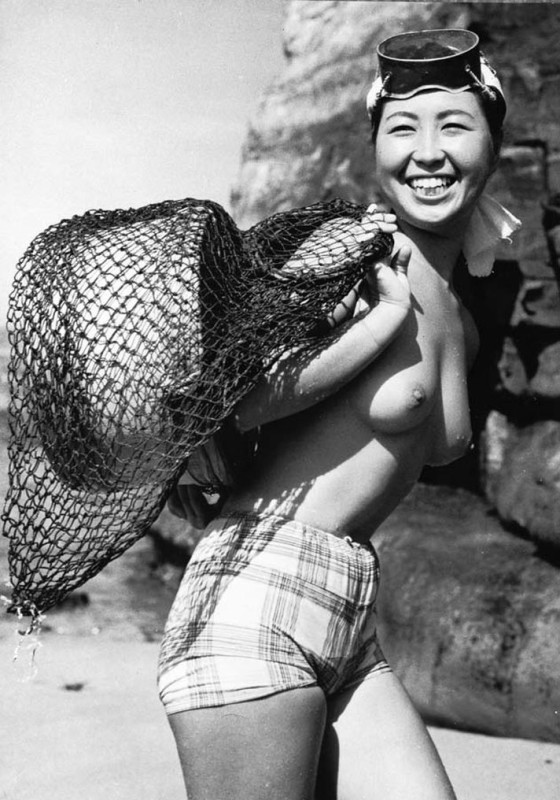
Although the tradition is still maintained across many parts of Japan, the skinny-dipping practices of old have largely been lost. Since the Meiji era, divers wore goggles for clarity and from 1964, rubbery, black wetsuits were introduced.
One photographer in particular stands out with his photographs of the Ama. His name was Yoshiyuki Iwase (1904-2001). He was given a gift of a small Kodak camera when young and found his muse in the beautiful mermaids of the tired, coastal regions of Japan. Thanks to his efforts, we can take a step back in time and have a glimpse at what life was like working as an Ama diver, and also see his progression as a photographer moving into nude portraits. Since his website is now offline, I’m gathering up as many vintage pictures as I can for posterity that I’ll post as its own separate article soon.
(Yoshiyuki Iwase)
One of the reasons Ama are largely female is said to be their thicker layer of fat than their male counterparts to help them endure the cold water during long periods of diving. Another reason is the self-supporting nature of the profession, allowing women to live independently and foster strong communities. Perhaps most surprisingly however, is the old age to which these women are able to keep diving. Most Ama are elderly women (some even surpassing 90 years of age) who have practiced the art for many, many years, spending much of their life at sea.
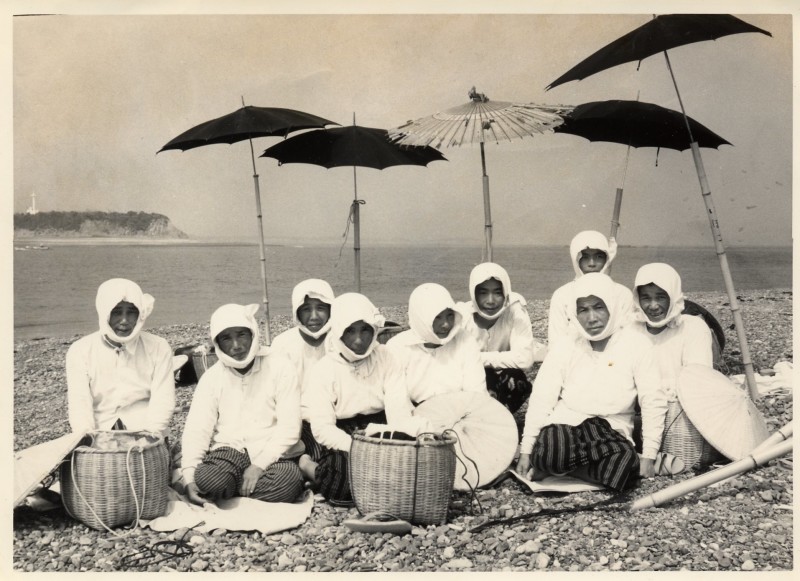
(Source)
With lack of young women to succeed their elders and modernisation of Japan’s fisheries however, this ancient practice is dwindling. Numbers have dropped to just 1/8th of what they once were. In 1956 there were 17,611 Ama in Japan but as of 2010 only 2,174 remained. Of those, 973 (nearly half) work in either Toba or Shima city, Mie prefecture. (FPCJ)
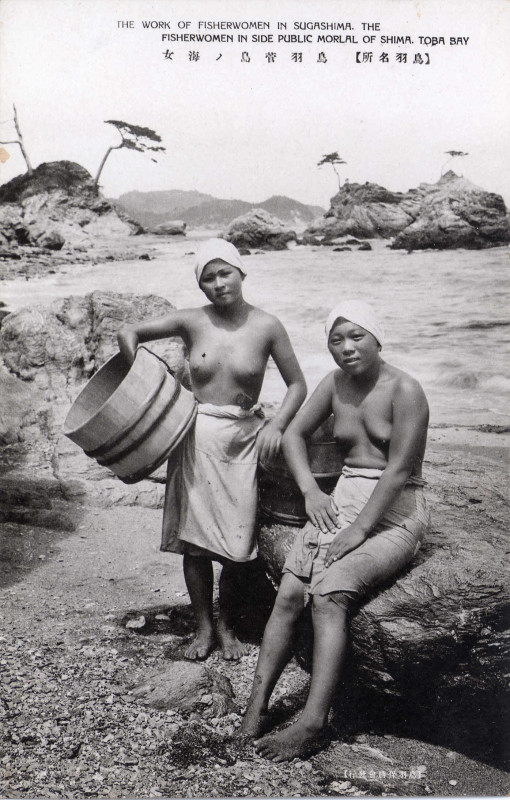
(Source)
As technology progressed, the Ama communities were faced with decisions – adopt new tools and equipment or retain traditions? One of the most important parts of the decision-making was consideration of sustainability. New fishing methods could easily enable greater hauls and reduce work, but at the same time, increase the risk of overfishing and damage the delicate ecosystems that supported life for these coastal towns. Rules were introduced to prevent this.
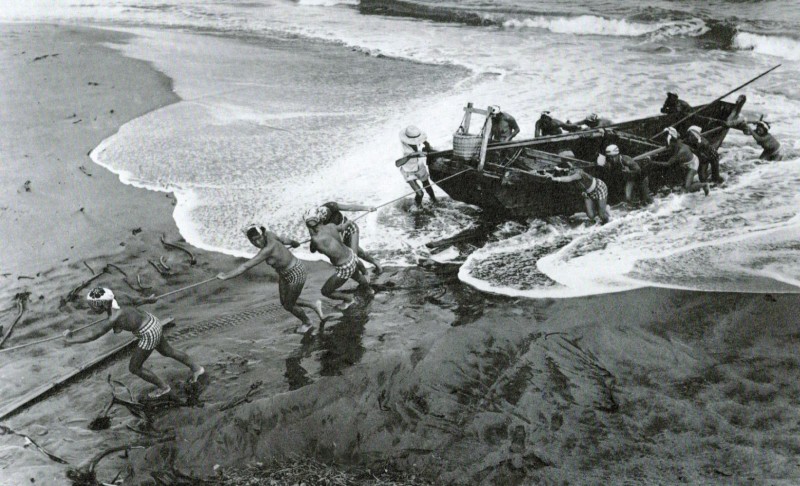
(Yoshiyuki Iwase)
On Hegura island in Wajima city, rules state that abalone under 10 centimetres must be returned to the sea, with a punishment of two days without work if caught breaking them. Despite their efforts however, numbers of abalone and other shellfish have been in decline, in part due to overfishing, but also the rising sea temperatures which affects the growth of seaweed the shellfish eat. (Source)
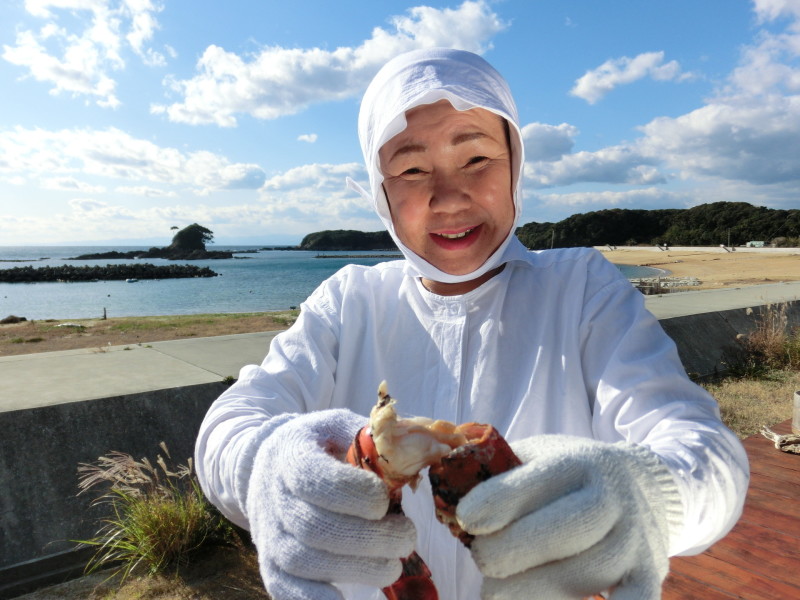
(Source)
This culture of national mermaids diving for the nation is not only unique to Japan however. From 2007 Korea has been presenting its best case to have the Haenyo divers of Jeju Island listed as a UNESCO Intangible Cultural Heritage. In similar fashion, Japan has now joined the races by recommending its own female divers, boosted by the popularity of a recent NHK drama ‘Amachan‘, starring a young girl who moves to the Tohoku region of Japan to became an Ama diver. (Asahi)
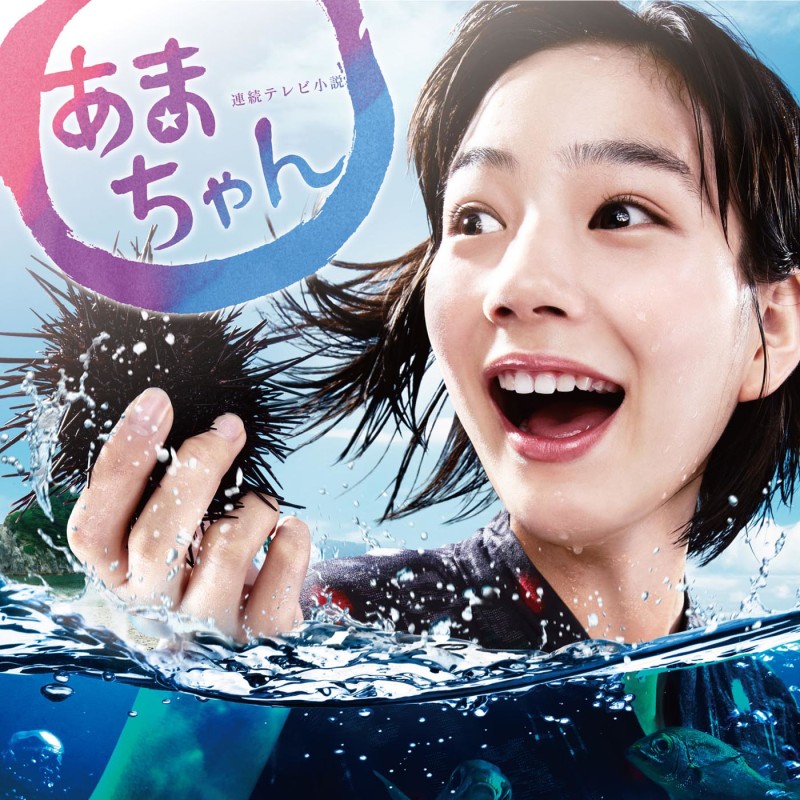
Although perhaps the scantily-clad, romanticised image of the profession is a thing of the past, there’s still a rich history and culture that needs to be conveyed to younger generations. The tourism industry at Mikimoto Pearl is a great start to help preserve the memory, but the age-old fishing traditions held by small coastal villages are definitely in need of special attention to make sure their heritage isn’t forgotten completely.
To wrap up, below are a few interesting related media that I stumbled upon. Enjoy!
Depictions of Ama are featured in old works of art, such as the piece below by master Kuniyoshi. (Source)
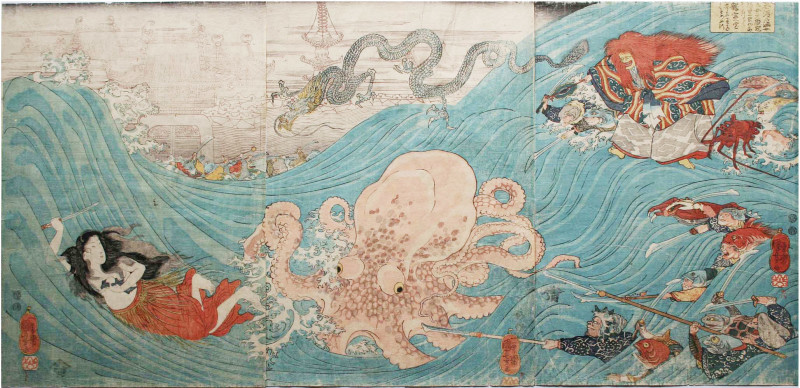
Predictably, there are also films made around the profession. Ama are featured in the famous work ‘Tampopo’, as well as the rather less famous, and slightly bizarre 1959 horror movie ‘Ama Ghost House’ (海女の化物屋敷). (Trailer below).
Finally, I’ll leave you with a couple of short videos talking about the Ama diving profession. The first is a superb documentary with an interview with a former Ama diver.
The second, although I have serious doubts about the validity of the narration, has rather nice, colourful video shots to enjoy. Just ignore the dialogue.
Lastly then, here’s the poem from the Man’yoshu that mentions Ama divers.
沖つ島 い行き渡りて 潜くちふ 鮑玉もが 包みて遣らむ (万葉集)









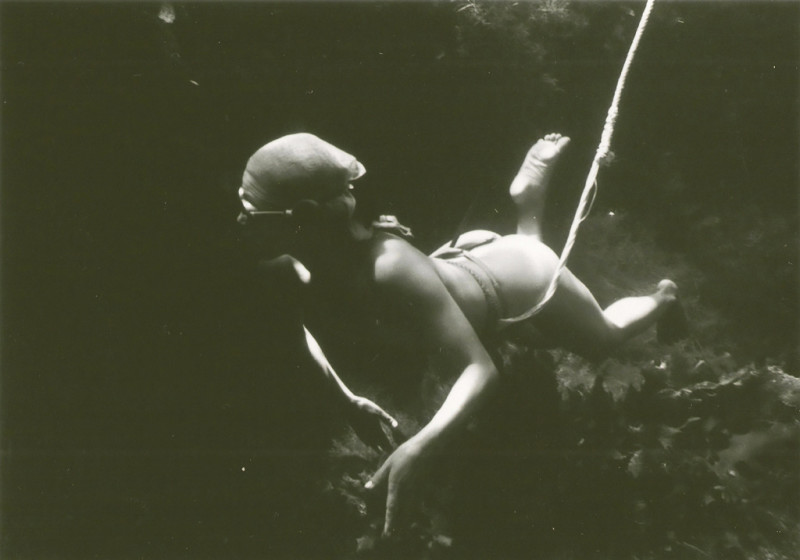
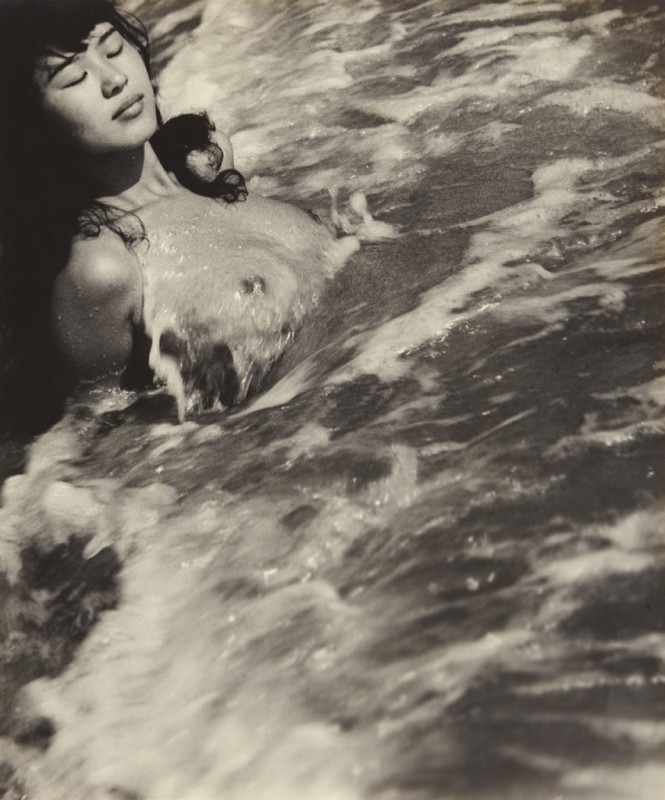
First viewed these images as a black and white newsreel at a movie theater in San Antonio Texas in the 1950’s as a kid. These are really beautiful then as they are today. I adore Japanese and their country and culture.
First viewed these images as a black and white newsreel at a movie theater in San Antonio Texas as a kid. These are really beautiful then as they are today. I adore Japanese and their country and culture.
In the 1950’s or very early 1960’s
Where is the poem you mentioned please?
Dear Michael,
I am working on a project revolving around Ama. Would you mind reaching out to me via email? I would love to have a conversation with you to learn more about specifics of Ama.
Thank you.
The commentary to the video is clearly very tongue in cheek. Maybe you need to study the British sense of humour.
[…] Ama sięga początków historii Japonii i jest wspomniana w najstarszej antologii japońskiej poezji […]
[…] Ama – The Pearl Diving Mermaids of Japan (Warning: Nudity … […]
I saw women diving in an old science fiction movie called revenge of the venus flytrap on dvd probabley made in 1967 or 68 they were topless didn’t know anything about intil I look into it
I saw women diving in an old science fiction movie called revenge of the venus flytrap on dvd probabley made in 1967 or 68 they were topless didn’t know anything about intil I look into it
[…] somewhat ninja-style, as a local coal miner. To further the cover, he is embedded with an Ama pearl diver named Kissy Suzuki, a perfect guise to get him close to the shore cliff castle. After some straight […]
Superb photos. I don’t think anyone will be offended by this type of nudity :-) Keep up the good art! Petra
I am amazed by the natural beauty of these women, long before the regrettable appearance of silicone applied to breast enhancement. It goes to show that beauty and nature and health are closely related.
Hey there, You’ve done an excellent job. I’ll definitely digg it and personally suggest to my friends.
I’m sure they will be benefited from this web site.
Thank you for this beautiful article. Please, can you translate the poem about the Ama into English? I am a poet and would love to know what it says in English. Thank you.
It doesn’t mention that Ama moved to and dived off Broom Western Australia until 1941, from the beginning of the century sometime, (mysteriously they left town just weeks before Japan attacked, and have never come back).
https://en.wikipedia.org/wiki/Amachan
You guys might want to check out the t.v. series that just ran a couple seasons in japan and was a big hit. about a high school girl who decides to become an ama
Even my ancestors were Pearl Divers, by the same way without any external help to breath; but they were men. Some of them even lost their life too, down water. They worked in ‘buddy pairs’ one being a close family member holding the rope end at boat. Those pearls were one of the main sources of income to Pandiya dynasty of South India, then. The cultural history & mass conversion in to Christianity of Tuticorin seafarer directly connected with pearl diving.
In 1958 Walt Disney released “People and Places: The Ama Girls”
The two men responsible for introducing me to the Ama were Walt Disney and Ian Fleming. Fleming’s novel “You Only Live Twice” came out after the Disney short.
I learned about the Ama from two men: Ian Fleming and Walt Disney. Ian Fleming’s James Bond in “You Only Live Twice” introduced both the ninja and the Ama to America. “People and Places: Ama Girls” (1958) predated the Bond movie and the 1964 novel.
There may have been other documentaries and works of fiction mentioning the Ama, but my introduction came from the works of those two men.
I am currently doing a project on this and I can not believe the braveness of these Ama Divers. I hope that the tradition continues forever!!!!!
This is a great article. We were truly inspired. We re in the course of creating a exposition about oysters in the NAVIGO- National Fisheries museum in Belgium. The exposition is called ‘The passion for oysters’… This theme would fit in great. Do you know were I can gastheer pictures? And who owns the rights to it? I would love to use this…
Can anybody help me? Greetings, Ineke
Just discovered the Ama in the book I’m reading called ‘Deep’ by James Nestor, a great read for anyone curious about free diving as well as marine life. There’s a wonderful quote from an Ama “When a man comes to the ocean he exploits it and strips it. When a woman puts her hand in the ocean that balance is restored.” The Ama believed that the ocean will always provide for humans if they gather from it in their natural forms, only taking what can be carried otherwise there will be nothing left. This is ancient wisdom that is very relevant today with our current over fishing practices.
Wonderful to discover this site and these stunning photographs!
That’s really interesting, it’s good to know this culture, we can see japanese women’s place in japan, a strong and responsible people, thanks for this page !
What a remarkable article. Would be a tragedy to loose this cultural heritage.
This was the most amazing story I have read and watched in my whole life! Thank you for sharing this, I think I was an Ama diver in my previous life, or hopefully I will be one in my next life, I love the freedom and connection between these women and the ocean.
Incredibly beautiful photos. Mishima’s short novel The Sound of Waves or Shiosai (1954) offers additional imagery of, and insight into, the disappearing wonders of the world of these women.
The Ama are featured in the James Bond film “You Only Live Twice”.
They are also in the James Bond Movie
You Only Live Twice (1967)
1 hadn’t heard of this either. amazing!
It’s a rare thing, stumbling upon an article that is interesting, well-written, and with beautiful images (of beautiful women!). It was a pleasure to read, even it’s length is just about ideal with the option of watching videos at the end. Thank you very much for your efforts.
these are some boss ass women
my parents had a whole book on these women when i was a kid. it had these great pictures in it. i think the name was beautiful swimmers or beautiful divers. something like that.
I didn’t want to leave without at least commenting on how beautiful this is. Even though such a lifestyle is very different from my personal up bringing and culture, it filled me with joy just thinking how ritual and tradition are so important to our humanity. In this case, the natural beauty of these women, the society in which they live and contribute to sustaining immensely, and the future of such a practice. That question still looms: at what point does one abandon tradition and adopt new practices? What does that do to our culture, Our community, our history? I am glad I do not have to answer these questions, for I appreciate both the old and the new. Oh life. You continue to perplex me. Thank you for sharing!!
This is amazing, I will thank you for sharing!!
Awesome information loved this story would love to do this one day awesome inspired sustainable fishing is so good.
Really fascinating article! Those women are really expert and beautiful!WOW!!!
Hi everybody,
how fascinating Ama history. And your article is a good summary indeed. Iwase photographs are magic, aren’t they ?
I’m back from Japan where I stayed last november. One of my trip’s purpose among many was to observe and encounter Ama. Few of them continue to make a living with shells collecting.
I intent to go there again for an in deep ( the expression fits so good!) photographic work to complete that I already began (sorry it’s just written in my native language, French!)
slowphoto. fr/plongee-au-japon-avec-les-ama/
Japanesement votre,
It’s rather sad that this title comes with the “Warning: Nudity” label. Why can’t we just appreciate the human form in its natural state without being prudes? It’s certainly not gratuitous and directly related to the history and culture of these women who dove so well.
Well it is because this day in age, the naked body has been perverted so badly that the word “naked” seems to mean the guy or girl is having sex or something.
Since many of the ama are now in their 70’s and 80’s, and seem both mentally sharp and physically fit, their lifestyle raises many important social and health questions. Women in those age ranges in the U.S. , make up the overwhelming number of patients confined to nursing homes and other long term facilities. Could a modified form of the ama regimen improve the quality of life for women in this country?
No doubt about it! Having an active lifestyle and eating good food are surely major contributing factors in enjoying a life full of quality and purpose. The salt water is also very healing.
“Survival of the fittest” is likely responsible for the ama’s health & longevity –it takes a lot to survive & prosper at this kind of work!!!
My American Mom is about 80 and she is traveling the world. So it’s not all Americans that are confined to wheel chairs and institutions.
Yes, I believe that an active lifestyle that including the incredible stimulating ocean is a definete health benefit.
Hi, I just ran across this blog. Very cool. Years ago, I saw an old work of art of an Ama diver holding an abalone. I’d like to purchase a print but haven’t been able to find it since. Do you know where I can find this artwork?
I remember as a kid at either Seaworld or Marineland there was an exhibit/show with pearl divers. I was always so intrigued at how they could hold their breath for so long. What a great read !!
Fantastic.. I was just looking around for inspiration for a illustration/3dModelling project.. This will do!
Mikimoto have a museum in Toba where they have divers do demos in the. White anti shark outfits.
Really beautiful!
If you haven’t done so already, read Maraini’s “Meeting With Japan.” Great book about the country before and after the war.
I found this website while cheating on a crossword puzzle. Thus my quest for a puzzle answer led me to find this great pearl. As a man I say with respect and awe, that I would have loved to have witnessed and shared in the time when women in loincloths dove into beautiful clear seas. No doubt someone of our era would romanticize such a time, but I embrace that illusion. I can’t wait to share the video with my wife and daughter.
It’s a tradition I really admire. As a woman, this is a showing of empowerment that we should be proud of. Diving without any equipment to aid them, these women defied the odds and showed to the world that we, women, can do incredible feats.
“It’s a tradition I really admire. As a woman, this is a showing of empowerment that we should be proud of. Diving without any equipment to aid them, these women defied the odds and showed to the world that we, women, can do incredible feats.”
An excellent reason that USA females should be required by USA federal law to sign up for the military draft as males are required to do. And, if the draft ever starts up again to achieve equity with the past an all-female military should be initiated until a rough parity has been attained with the numbers of males wounded and killed fighting war in prior conflicts. To ease the accounting let’s start with World War Two. Seems fair to me. Especially with today’s modern empowered women.
wow.
Great idea, Obbop! Certainly you’re not being unnecessarily short-sighted in your lack of historical/political analysis. Surely your suggestion is much more logical than ending these wars which are started and run and funded predominantly by men in the first place! And for the sake of posterity, we’d better make up for all of those years that men had the sole vote and women were property of their husbands – let’s switch it up! And we should pay men less for the same work hour in the office, and nothing at all for whole lifetimes of unpaid house-husbandry and 24/7 parenthood. I’m glad you brought this up. Good talk.
THANK YOU. Obbop needs to work on a better argument.
You’re assuming that women would not have been happy to go to war if they had been allowed which is stupid. Blaming women living now for events of the past is double stupid. You are also ruining a lovely comment stream with an aggressive attitude, shoo troll, we are here to read about beautiful things xxx
way to disrespect and discredit the contribution of women during wartime, but moving along..
She said that women can do incredible feats – not that all women and men can do the exact same incredible feats. I, as a small woman, would be pretty useless at war. That isn’t to say ALL women would be – my sister would probably be a great soldier. I can understand if your contribution here was ‘soldiers should be drafted based on strength and ability in combat.’ I’d agree with that. (But from what I can gather you’re taking issue because someone acknowledged that women can achieve ‘incredible feats’. Do you realise how pathetic and bizarre that is?I The hate must run deep!)
Besides – You want to attain a rough parity for gender inequality of the past? LOL. Be my guest! But lets go the whole way shall we? and consider the full scope of what women of the past actually put up with. Or do you not know about or acknowledge that?
Also lets change the gender representation in government and in big business also, in parity with the past! I mean, if women will be fighting these wars, it’s only fair that they be the ones starting them too!
No way, as a small person you would have been extremely valuable in service during war time. Smaller people can escape better, are harder to detect, make better sniper rifle shooters, etc. In hand to hand combat, with proper training, smaller people can evade and redirect (think Akido) incoming assaults, and are harder to shoot due just to their small size. And as a woman (especially during WW2) the enemy would be less likely to guess you worked for the other side (Because a woman? During war!? No way!), making you a valuable asset as a potential spy. Don’t underestimate yourself because of your gender or size.
I don’t think the draft should exist, period, but I most definitely agree there should be a place for women in the military and especially on the front lines. This archaic gender bullshit is affecting our ability to defend our own country and it has got to stop.
Empowering and beautiful. Where are the strong American women repairing our sewers, welding underwater pipes and shoveling manure?
You already do. You give life.
This might offer some insight into the adage that men are the sprinters (& hunters) & women are the long-distance runners (& gatherers & planters — cultivators & pruners) … anybody following the IDIDEROD RACES (Alaskan sled runs) would note that on a dog sled, women seem to have the stamina for the long, tough haul!!!
What a beautiful tradition. I wish it was never changed or capitalized on. The world had such unique and amazing features before the industrial age took full hold. Now all that’s left is the memory of it all.
True, but you can’t stop change, industrial revolution damaged some things brought other good stuff. That’s life, change and evolution, ups and downs etc.
Excellent article, i didn’t know about it, very interesting also the fact that it was done by women. Sponge diving, in some islands of Greece, was the only way to earn your living in the past, but it was men that were diving. A 15 kilograms stone was taking the divers down to the bottom quickly. They often went down to about 30 metres (100 ft) for up to 5 minutes.Some of them more than 100 years ago discovered the Antikythera Mechanism, the oldest analog computer.
Look for a book called The Physiology of Breath Hold Diving and the Ama of Japan. A great scientific account of what these remarkable women can do.
We need more nude pictures of these chicks.
Way to show your classy side.
Very good website – helped me learn more on the diving history.
Dear Michael, pearl divers are a fixture in islands of the pacific, it’s great that this practice can be recognized by Unesco….
A little note though: In japan female divers were non existent as men were the only ones allowed to do that until the 19th century. At that time the taxation system made women possible divers but also made their activities tax free which had the effect of pushing a lot of poor female into the job. Remember, It was NOT a good or well regarded job and the romanticism about it is only in retrospect.
A few years ago I found a unique book by Horace Bristol on his photography of Japan, from 1949. Inside, there are 14 booklets of his photos and observations. One of the booklets talks about the Ama in a different location, and pearl cultivation in general. The photography is really amazing and provides a record of a way of life that is tending to become more rare. You can find out more about it here.
I hadn’t heard of this either. Pretty cool!
I have never heard of this! How amazing! I would love to visit there some day and possibly try myself. Thank you for sharing!